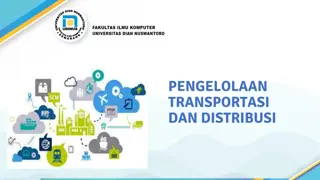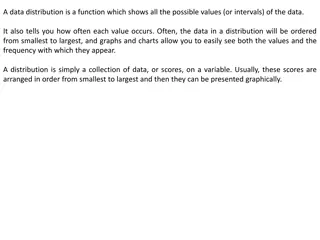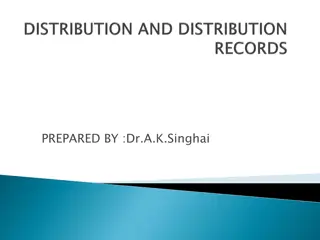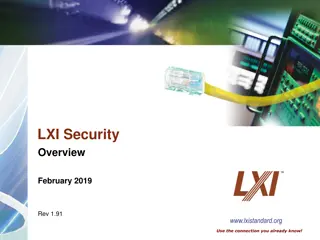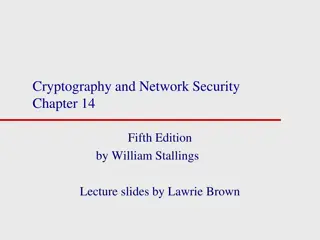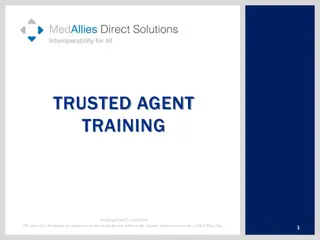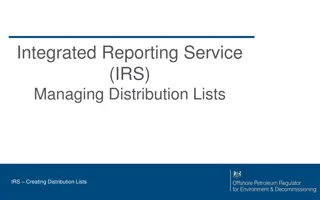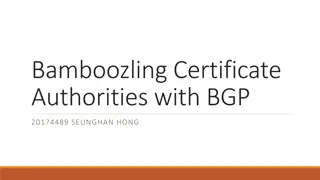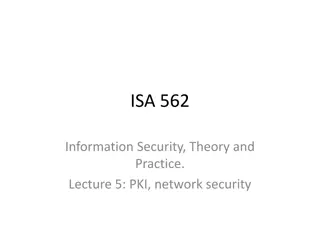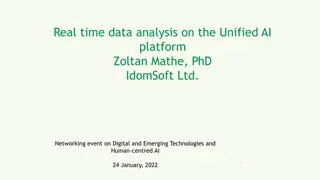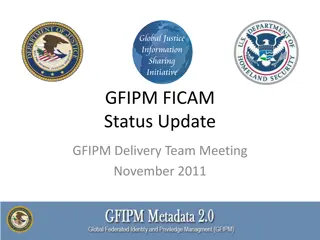
Enhancing Security in Key Distribution and Exchange
Explore methods for distributing public keys securely to prevent man-in-the-middle attacks. Learn about public announcement, publicly available directories, public-key authorities, and certificates for trusted key exchange.
Download Presentation

Please find below an Image/Link to download the presentation.
The content on the website is provided AS IS for your information and personal use only. It may not be sold, licensed, or shared on other websites without obtaining consent from the author. If you encounter any issues during the download, it is possible that the publisher has removed the file from their server.
You are allowed to download the files provided on this website for personal or commercial use, subject to the condition that they are used lawfully. All files are the property of their respective owners.
The content on the website is provided AS IS for your information and personal use only. It may not be sold, licensed, or shared on other websites without obtaining consent from the author.
E N D
Presentation Transcript
The road to PKI Key distribution and exchange
Yes, Diffie-Hellman exchange works, but Distributing public keys is subject to MITM Need of a way of having trusted public keys
Distribution of Public Keys Distribution methods: 1. public announcement with optional one time install (pinning) Example: SSH infrastructure 2. publicly available directory Example: PGP infrastructure 3. public-key authority Dynamic publication and verification of public keys: similar to OCSP protocol 4. public-key certificates Example: the real PKI
Public Announcement users distribute public keys to recipients or broadcast to community at large eg. append PGP keys to email messages or post to news groups or email list major weakness is forgery anyone can create a key claiming to be someone else and broadcast it until forgery is discovered can masquerade as claimed user Example: SSH servers
Publicly Available Directory can obtain greater security by registering keys with a public directory directory must be trusted with properties: contains {name,public-key} entries participants register securely with directory participants can replace key at any time directory is periodically published directory can be accessed electronically still vulnerable to tampering or forgery
Public-Key Certificates certificates allow key exchange without real-time access to public-key authority a certificate binds identity to public key usually with other info such as period of validity, rights of use etc with all contents signed by a trusted Public-Key or Certificate Authority (CA) can be verified by anyone who knows the public-key authorities public-key
Public-Key Certificates Issuing a CSR Signed CSR becomes a certificate
The main, biggest assumption The CA is trusted and its public key is pinned somewhere in a secure place E.g. in the operating system / browser / java keystore
Certificate contents (x509 format) Common Name CN Public key associated to the common name CN Validity window OCSP coordinates, CRL coordinates Other fields (purpose, ecc.) Digital signature of a CA authority
Certificate creation A certificate request (CSR) is produced by X and submitted to a CA The CSR contains PU_X A RA (registration authority) validates the requests from X and submits it to the CA. CA trusts RA and good security practices are assumed Success: a new certificate C is issued. C contains PU_X, and it s signed with PR_CA Failure: no new certificate is issued
Examples of RA validation practices When validating Web Sites + FQDNs X must prove to control corresponding DNS, or prove to own the web server For EV certificates, needs also personal identification and other legal stuff When validating people Legal identification of X (Photo ID, webcam, etc.)
CA public keys installation These are installed one-time in a, tipically OS-wide data structure (the truststore), and replaced from time to time: In case of certificate expiration In case of revocation When a new CA is accepted Root CA public keys are within self-signed certificates, and are necessary for validation Keystores/Truststores become a hot security point
Example of keystore tampering Avast Web Mail shield Almost any commercial AV used to this (and still does in a way or another)
Example of CA private key theft The Diginotar case and many more
Certificate validation All these checks must be successful: Identity check: some of the CNs should match the identity you re looking for Signature check: Digest must correspond to a known and accepted public key of a CA in the keystore Validity time window must fit with current time Certificate scope must match (can t use a certificate for authorizing things not in the certificate scope) Certificate must not be revoked Quality check must be ok
Digest check C = Certificate to be checked D = Fingerprint of C D = E(Pr_CA, H( C ) ) C H( C ) = D( Pu_CA, D )
Certificate revocation check Alternatives: Via an OCSP server. The OCSP server must be trusted on its own. The OCSP URL is usually in a certificate field Performance problem and an example of possible domino attack Availability Confidentiality+Integrity Via download of huge CRL txt files Big performance problem OCSP Stapling
Usage of public keys in certificate BasicConstraints: CA true or false, pathlen KeyUsage values: digitalSignature, nonRepudiation, keyEncipherment, dataEncipherment, keyAgreement, keyCertSign, cRLSign, encipherOnly and decipherOnly
Other known PKIs Usages Code signing PKIs: accountability of software packages Public administration PKIs: legal documents, document storage Digital Rights Management: distribution of decoding keys, etc.
Extended key usages Value Meaning ----- ------- serverAuth SSL/TLS Web Server Authentication. clientAuth SSL/TLS Web Client Authentication. codeSigning Code signing. emailProtection E-mail Protection (S/MIME). timeStamping Trusted Timestamping OCSPSigning OCSP Signing ipsecIKE ipsec Internet Key Exchange msCodeInd Microsoft Individual Code Signing (authenticode) msCodeCom Microsoft Commercial Code Signing (authenticode) msCTLSign Microsoft Trust List Signing msEFS Microsoft Encrypted File System
PKI Assumptions and its attack surface from ten risks of PKI 1. Trust your CA and its CPS (Certificate Practice Statement) 2. Trust that a private key will be handled only by the legitimate handler (legal assumptions) 3. Trust the verifying computer/browser and its own root certificate list 4. The CA trusted list is as weak as the weakest CA in the bunch 5. Trust the association between Identity Certificate (homonymies are possible)
PKI Assumptions #2 5. Trust that CA is an authority on the binding which CA signs for (e.g. DNS, e-mail) 6. Assumes that user understands (part of) PKI 7. RA+CA binding is trusted 8. RA well identifies the certificate requester 9. Certificate practices (CSP) are respected 10. Single sign-on practices are a problem
Signing devices PKCS #11 tokens HSMs


